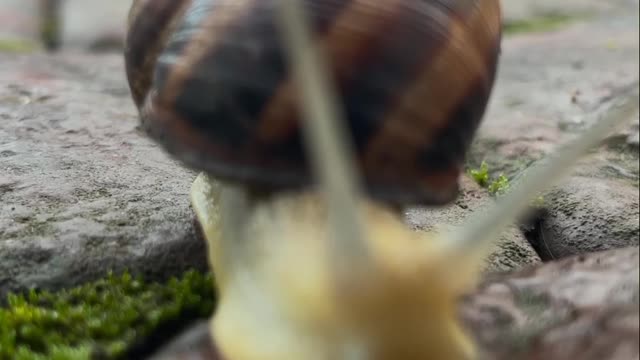Premium Only Content

The snail is found on the beach. Watch his video
Snails are found in many climates including deserts, rivers and streams, closed reservoirs, reservoirs and coastal areas. Although terrestrial snails are known to most people, they are actually a minority in the snail world. Marine snails are far ahead in diversity and numbers. Snails abound in freshwater and even saltwater. Most snails are herbivores; However, some marine snails are amphibians or carnivores.
Some snails breathe through their lungs. These are called palmonata. On the other hand, snails that breathe with the help of gill organs are grouped into paraphyletic groups. Land-dwelling snails have two pairs of tusks on their heads that can be rolled up if needed. The eyes are in the back aisle. Aquatic snails have a pair of unsuitable tusks that have eyes at the base [1].
The shell of the snail is made in the shape of a spiral. Most shells are right-handed, meaning that if the upper part of the center of the shell is aimed at the viewer, the punches or spirals will rotate clockwise. Most snails slip on muscular legs covered by epithelial cilia, which are slippery with mucus [2]. The snail moves by contracting the leg muscles repeatedly. This movement of the muscles can be clearly seen by looking at the snails climbing the walls of the aquarium. Snails move very slowly (normal speed of 1 mm / s in the case of adult Helix lucorum snails [3]). The mucus in snail's legs reduces friction and helps them to slip. This mucus also helps prevent snails from being bitten by sharp objects. Because of this, snails can pass through sharp objects such as razors or blades but do not cut through their bodies. [4]
The lifespan of different species of snails is different. In nature, snails live for 5 to 6 years in Aquatinidae and snails of Helix species live for 2 to 3 years. The lifespan of aquatic apple snails is only one year. Most snails die either at the hands of predators or by parasites. The life span of snails is much longer in captivity, from 10 to 15 years for most species. Some snails live longer, up to 30 years [5].
Eating habits
While in nature, snails eat a variety of foods. Terrestrial snails are herbivores. They eat leaves, soft bark of trees, fruits, vegetables etc. Since some species of snails damage crops and orchards, they can be classified as pests. Aquatic snails eat a variety of foods such as plankton, algae, plants and other aquatic microscopic organisms.
-
 1:01:05
1:01:05
Jeff Ahern
4 days ago $1.61 earnedFriday Freak out with Jeff Ahern
20.9K8 -
 1:51:40
1:51:40
Redacted News
3 hours agoHIGH ALERT! TRUMP IS COMING FOR CHICAGO, U.S. TROOPS PREPARING INVASION TO STOP MURDERS | REDACTED
117K187 -
 2:10:45
2:10:45
Red Pill News
5 hours agoJustice Is Long Dead in The DC Circuit on Red Pill News Live
40.1K13 -
 1:17:50
1:17:50
Awaken With JP
6 hours agoTrans Shooter is the Victim, Vaccines in Trouble, and Greta is Ugly - LIES Ep 106
68.4K25 -
 2:04:31
2:04:31
Pop Culture Crisis
5 hours agoJK Rowling Calls Out HARRY POTTER Director, Sydney Sweeney Dating Scooter Braun? | Ep. 909
35.6K2 -
 1:02:42
1:02:42
Sarah Westall
4 hours agoRemote Viewers: Philadelphia Experiment, Alien Abduction and Future Events w/ the Rabbit Hole Group
20K3 -
 56:03
56:03
SGT Report
20 hours agoSILVER'S HISTORIC BREAKOUT -- Chris Marcus
45.8K10 -
 LIVE
LIVE
LFA TV
13 hours agoLFA TV ALL DAY STREAM - TUESDAY 9/2/25
869 watching -
 19:57
19:57
Professor Gerdes Explains 🇺🇦
5 hours agoDecoding Putin's Shanghai Narrative: The Strategic Goal Behind the Lies
13.5K2 -
 1:16:16
1:16:16
vivafrei
5 hours agoTrans Violence Canadian Media is IGNORING! Activist Judge vs. Trump AGAIN! Ostrche Update & MORE!
61.2K50